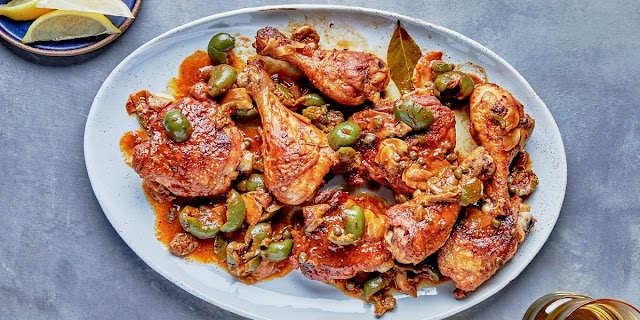Chicken Puttanesca
 |
| Chicken Puttanesca |
3 lb. skin-on, bone-in chicken thighs and drumsticks or whole legs
Kosher salt
6 garlic cloves, thinly sliced
4 oil-packed anchovy fillets
½ tsp. crushed red pepper flakes
1 cup Castelvetrano olives, crushed, pits removed
¾ cup dry white wine
2 fresh bay leaves (optional)
3 2" strips lemon peel, plus lemon wedges for serving
Preheat oven to 350°. Pat chicken dry with paper towels, then season all over with salt.
Heat 2 Tbsp. oil in a large skillet over medium-high until shimmering. Cook chicken, turning occasionally, until it has rendered some of its fat and skin is golden brown all over, 7–10 minutes. Transfer chicken to a plate. You’ll have a pool of fat left in the pan. Spoon out all but 3 Tbsp. fat from pan. (Use it for roasted potatoes, in cooked bitter greens, or add to stewy beans.)
Reduce heat to medium and add garlic and anchovies to skillet. Cook, stirring often, until garlic is softened and anchovies have disintegrated, 2–3 minutes. Sprinkle in red pepper flakes, then stir in tomato paste. Cook, stirring occasionally, until tomato paste begins to split and stick to pan, about 3 minutes. Add olives, wine, capers, bay leaves (if using), and lemon peel and bring to a simmer (still over medium heat). Cook, stirring occasionally, until most of the wine has evaporated, 5–7 minutes.
Snuggle chicken (skin side up) into sauce in a single layer. Pour in 1 cup water and bring to a simmer. Transfer skillet to oven and bake, uncovered, until sauce is thickened and chicken is cooked through, 20–25 minutes (if using whole legs, it’ll take closer to 30–35 minutes). Taste a spoonful of the sauce—it should be plenty salty between the anchovies and capers, so you most likely won’t need to season with more salt.
Transfer chicken to a platter and spoon sauce over. Drizzle with oil and serve with lemon wedges alongside.








Growing up we had dairy dinners– fish, or pasta– and were given milk to drink. On meat dinners- we had juice or water. Never soda. One night- for dairy dinner– my mother served waffles and ice cream with hot fudge and wet nuts. and that became a regular treat.
ReplyDeleteSo now that I have children- when we were at a NJ shore vacation, we always went at least once a summer for Dairy Dinner– and I often served it at home. Now that my kids are in their twenties- they think they are too grown up for dairy dinner– So once a summer , at least, my 60 something girlfriend and I go out for Dairy Dinner– coffee ice cream, fresh waffles, hot fudge, and wet dinner. My daughter knows that my new granddaughter will behaving dairy dinner
My niece- at age 8- was invited to stay for dinner at a friend’s house for dairy dinner She started to sob, when dinner of flounder was served. Not the dairy dinner she expected that her mom learned to serve. We still joke about her failed Dairy Dinner
These are all such great stories! My siblings and I grew up in a quasi-kosher home, but when we visited our maternal grandmother all bets were off. In addition to eating BACON and shrimp at her house, she also bought sugary cereals for us (Applejacks!) that we were never allowed at home. I was not particularly close to my grandmother, but just by having those special foods on hand for us, I now have fond memories of visiting her.
ReplyDeleteMy mom really made an effort in the kitchen for us and her thoughtfulness in that regard will always stay with me. We lived in a very small, Southern town without a lot of ethnic food options available (e.g. we grew up eating ketchup on our tacos, I think because salsa was not yet available in our local grocery!). About every six weeks, my mom would make a grand Chinese food feast (stirfry, szechaun chicken salad, egg drop soup) from scratch. She even served it in special dishes that she bought at an import store in the big city and taught us all to use chopsticks!